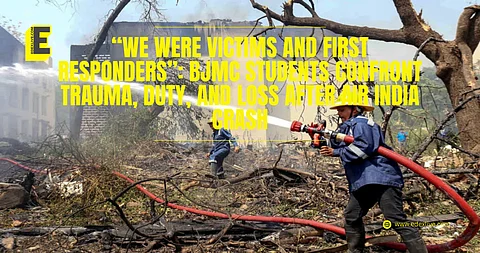

The afternoon of the crash began like any other.
Dr Raj, intern at BJ Medical College, was driving along SG Highway in Ahmedabad when the first notification of the news appeared on his phone: a chartered plane, he initially assumed, until the devastating truth emerged.
An Air India flight had plummeted directly into their medical college hostel mess hall. “I genuinely have no words to describe the emotions that followed,” he reflects. “Fear, disbelief, helplessness, it all hit at once.”
EdexLive spoke to students and doctors present at the site of the crash, many of whom are still grappling with the trauma of witnessing the devastation firsthand. Their accounts offer a sobering look at the toll the tragedy has taken: physically, emotionally, and institutionally.
For Dr Kruthik, an intern who was inside the hostel when catastrophe struck at 1.39 pm, the experience was harrowing and immediate. “The crash hit the mess hall directly. Chaos, dust, screams, in those seconds, it felt like the world had collapsed around us.”
Within moments, debris had scattered, and thick smoke billowed through the area. The fragility of life became starkly and painfully visible.
The response was swift, yet surreal. Emergency teams, National Disaster Response Force (NDRF), Central Reserve Police Force (CRPF), police, and medical services, converged on the scene within fifteen to twenty minutes. “The response was fast and coordinated, but the scene was chaotic,” Dr Kruthik recalls. "It was overwhelming to witness.”
In the residential quarters of the Athulyam complex, the shock was deeply personal. Dr Geeta Krishna, a third-year surgical oncology resident, was on hospital duty when disaster struck his family at the residential building.
“The plane hit the mess, but the force of the impact and flying debris also struck our residential building,” he explains. “Some debris hit my mother, but thankfully, people rushed to help and managed to rescue my wife, baby, and mother.”
His mother now suffers from panic attacks and PTSD and is under psychiatric care. His baby developed respiratory issues from smoke inhalation. “We were lucky in many ways. It was lunchtime, so most residents were awake and could run. But the fear hasn’t left us yet,” he says.
Manav, a final-year MBBS student, was also in the residential block when the crash occurred. “I heard a deafening noise. The entire structure shook, and I saw smoke rising through the windows.” Many residents initially thought it was a bomb blast. “Within five to ten seconds, the entire area was engulfed in smoke,” he remembers. “We barely had time to process what was happening.”
The Athulyam complex bore the brunt of the destruction, with blocks 1, 2, and 4 suffering the most severe damage. The aircraft's trajectory, first striking the mess hall and main entrance gate before scattering debris between residential blocks, unleashed devastation. “That's where we saw the highest number of casualties,” Dr Geeta Krishna notes.
In the immediate aftermath, hierarchy dissolved in the face of human need. Dr Raj, who has barely slept since the incident, observes how the tragedy transformed their community: “I've seen even the cleaning staff step in to help families of patients. Hierarchies have disappeared in the face of grief.”
The medical students and residents found themselves simultaneously victims and first responders, their training compelling them to serve while their hearts grappled with personal loss.
The human cost extends beyond physical injuries. Families have been providing DNA samples for victim identification, with results expected within 72 hours, a clinical process that underscores the devastating scope of loss.
With the residential blocks uninhabitable, the college has arranged temporary accommodation within hospital premises. Academic schedules have become irrelevant; as Dr Raj puts it, “There's been no formal update about academics yet, but honestly, none of that matters right now. The humanitarian crisis at hand overshadows everything else.”
The students cope by staying useful, throwing themselves into hospital work: trauma centres, emergency rooms, wherever hands are needed. “There's not much time to process what's happened,” Dr Kruthik admits. “Keeping busy is the only way we know how to cope right now.”
As the immediate shock begins to settle into the long process of grieving and rebuilding, these young medical professionals carry forward both the trauma and the profound lessons of that afternoon. They've witnessed how quickly everything can change, experienced both human fragility and resilience, and learned that in the face of unimaginable tragedy, the simple act of helping others becomes both a duty and a form of salvation.
“What's striking is how quickly everything can change,” Dr Raj reflects. “We're seeing both the fragility of life and the strength of the human spirit.”
In their words lies not just testimony to tragedy, but evidence of the enduring capacity for compassion that tragedy cannot destroy.
